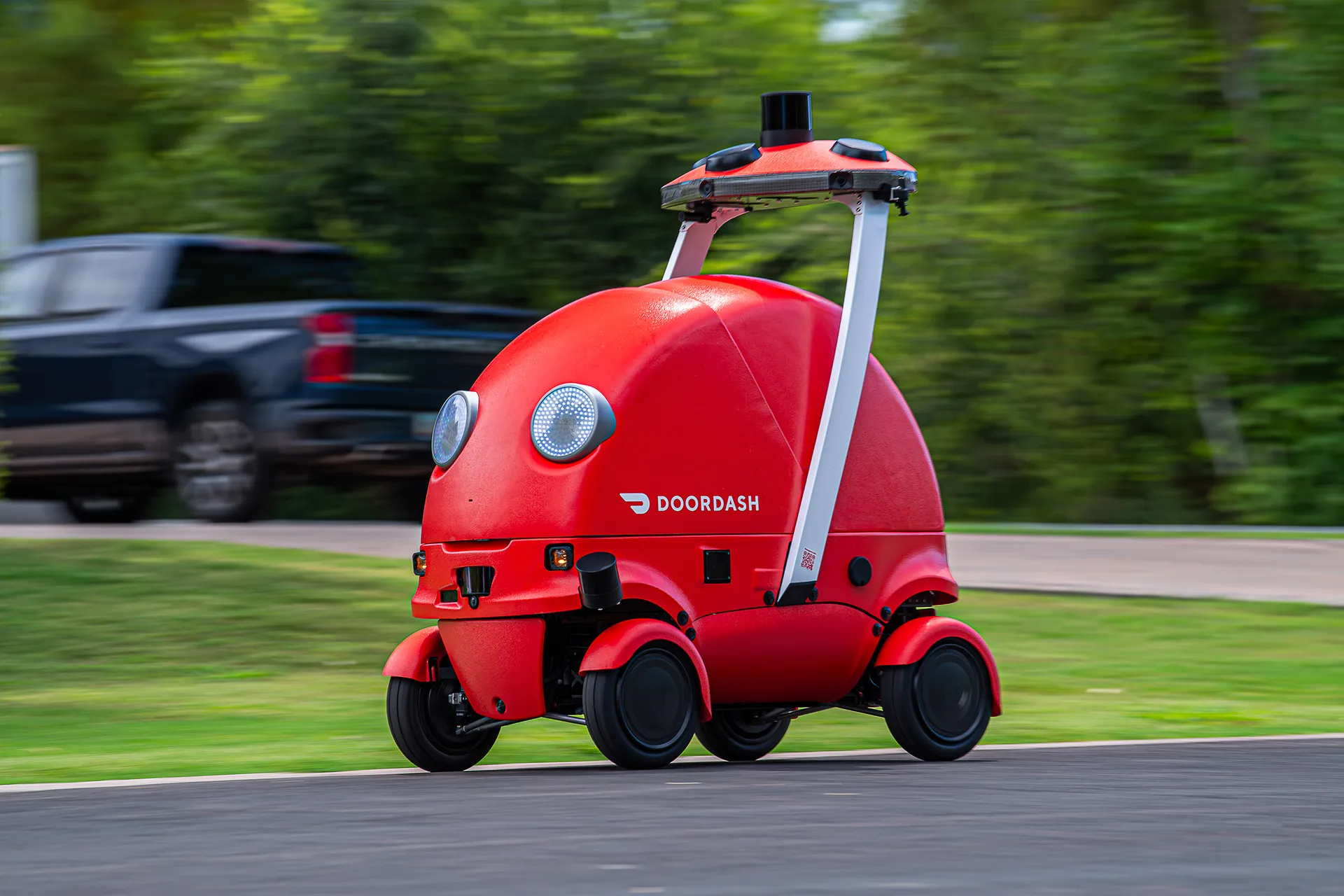DoorDash’s Dot delivery robot is reshaping the future of food and local-goods logistics with its ability to travel on sidewalks, bike lanes, and roads — a capability that sets it apart from past delivery bots. As autonomous delivery technology accelerates.
Dot: The Next Step in DoorDash’s Autonomous Strategy
Dot is not just another sidewalk bot. DoorDash has developed it in-house under its DoorDash Labs division, aiming for something more ambitious: a delivery robot that can seamlessly shift between sidewalks, driveways, bike lanes, and even roads.
It measures about 4½ feet tall, weighs approximately 350 pounds, and can carry up to 30 lb of cargo — enough for roughly six pizza boxes. Dot’s top speed is 20 mph on roads, with slower, more cautious speeds on sidewalks and in dense pedestrian zones.
To make sense of where Dot fits in, DoorDash has launched an Autonomous Delivery Platform — essentially an AI dispatcher that decides whether a human Dasher, a Dot robot, or even a drone is the best option for each order. This multi-modal approach is central to DoorDash’s vision of scalable, flexible local commerce.
Dot is currently being tested in the Phoenix metro area (Tempe, Mesa, and surrounding suburbs) under an early access program. DoorDash aims to expand its reach over time to suburban neighborhoods in other U.S. metro areas.
Why Dot Is Different (and Risky)
Unconstrained routes: Most previous delivery bots were limited to sidewalks and relatively flat, pedestrian-heavy zones like college campuses. Dot’s ability to traverse bike lanes, streets, driveways, and even parking lots gives it a much broader operational scope.
Door-to-door coordination: Dot is built to pull right up to restaurant entrances and operate without the typical staging zone many delivery bots require. This reduces friction for both restaurants and customers.
Personality matters: DoorDash intentionally gave Dot “friendly” design features — LED “eyes,” chime-like noises, and animated greetings — to help with social acceptance as it interacts with people on sidewalks and in public spaces.
However, Dot’s ambitious design comes with challenges:
- Stairs and elevators: Dot cannot navigate stairs or elevator shafts. It relies on flat paths and ramps.
- Regulatory and safety concerns: Sidewalk bots have already faced issues — blocking paths, conflicting with wheelchairs, or being physically bumped. Running in bike lanes and on roads complicates the regulatory environment further.
- Public trust and vandalism: These robots are exposed to the elements and to human behavior — they might get kicked, vandalized, or tampered with.
- Logistics complexity: The technology must robustly detect and respond to a wide variety of real-world obstacles: vehicles, pets, children, curb edges, unexpected objects, and unexpected human behavior.
Wired, for instance, notes that many earlier delivery robot projects have scaled slowly or folded altogether. Amazon canceled its Scout program; other companies pivoted. That history underscores how far Dot has to go to prove its viability.
DoorDash’s Broader Autonomous Push
Dot is not happening in isolation. DoorDash has already been experimenting with autonomous delivery in other forms:
- Through a partnership with Coco Robotics, DoorDash has deployed sidewalk delivery bots in cities like Los Angeles and Chicago, working across ~600 merchants.
- Through a relationship with Wing, DoorDash has expanded drone delivery in parts of the U.S., including Charlotte and the Dallas–Fort Worth region.
- DoorDash has emphasized that not every order needs a car — for short-distance deliveries, robots or drones may be more efficient, cost-effective, and environmentally friendly.
As DoorDash scales Dot, its Autonomous Delivery Platform becomes even more critical. That system dynamically chooses which mode to assign (Dasher, robot, or drone) based on metrics like speed, cost, complexity, and geography.
In short, Dot is DoorDash’s bold move to own more of the robotics stack — not just partner externally — and to ensure it has flexibility over how last-mile logistics evolve.
Market, Operational & Competitive Reactions
Investor sentiment: Initial reaction was cautious. DoorDash’s stock slipped slightly upon revealing Dot and the expanded autonomous strategy. Nevertheless, the company’s boldness signals its long-term bet on robotics and autonomy.
Industry context: The autonomous delivery space is crowded with high expectations and past failures. Uber, Amazon, and Starship have tested robots or autonomous vehicles; some have retreated or retooled. Dot’s positioning is bolder — its ability to mix in roads and bike lanes gives it a different niche, but also draws on challenges akin to robotaxi development.
Labor impact: Some Dashers (human delivery drivers) may question whether Dot threatens their livelihood. However, DoorDash has emphasized that humans will still carry most bulk and complex orders, especially where Dot cannot reach.
Technical scaling: Dot is currently in the early stages. To reach broad deployment, DoorDash must refine edge-case handling, durability, maintenance, regulatory compliance, and public acceptance.
Local regulation & public safety: Municipal rules vary. Sidewalk rights, curb access, bicycle lane rules, and pedestrian safety must all be addressed locally. Some communities may balk at robots on sidewalks or mixed traffic. The Washington Post
Conclusion
DoorDash’s Dot robot is far from a gimmick. It represents a bold step in an evolving realization: that the future of deliveries will be multi-modal. Dot’s ability to move across sidewalks, bike lanes, and roads—coupled with DoorDash’s Autonomous Delivery Platform—positions it as a major bet in the race to solve the “last 10 feet” problem in logistics.
Yet many challenges remain: navigating complex real-world terrain, gaining public trust, scaling cost-effectively, and working through regulation. Whether Dot succeeds or stumbles, it will shape how we think about urban and suburban delivery for years to come.
Subscribe to trusted news sites like USnewsSphere.com for continuous updates.





